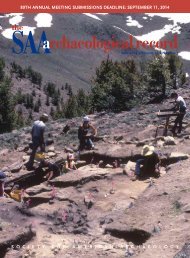SAA
Nov2016_web
Nov2016_web
Create successful ePaper yourself
Turn your PDF publications into a flip-book with our unique Google optimized e-Paper software.
VIDEO GAMES AND ARCHAEOLOGY<br />
Figure 2. Map with GPS coordinates of a relic from Tomb Raider: Definitive Edition (Crystal Dynamics). Screen capture by Andrew Reinhard.<br />
both real and virtual worlds: recover and document artifacts<br />
and their context, analyzing assemblages and stratigraphy to<br />
make connections between their deposition and history of<br />
manufacture/use.<br />
Archaeogamers need to be able to discover, identify, and<br />
record stratigraphy, context, features, assemblages, deposits,<br />
intrusions, spits, and artifacts, clearly defining what those<br />
are within the archaeogaming vocabulary, making these<br />
intelligible to real-world archaeologists and the public at<br />
large. There will be some natural overlapping with archaeological<br />
survey (fieldwalking) and landscape archaeology, and<br />
exploring the history of use, be it an entire game or something<br />
found within the game.<br />
When archaeologists dig, they can either do so carefully,<br />
being mindful of stratigraphy, or they can dig “out of phase,”<br />
plunging straight down without regard to stratigraphic layers.<br />
It is possible for archaeogamers to “dig” in phase when<br />
treating the games themselves as artifacts, especially when<br />
dealing with variations in game-builds and versions. Seeing<br />
something in version 1.0 might be gone in version 2.0.<br />
Revisit the findspot between versions. This is not unlike<br />
removing soil above an artifact, recovering the artifact, and<br />
then continuing down. In games, there really is no gravity or<br />
centuries of accumulated dirt. There are, however, layers of<br />
versions. This creates archaeological context within a game<br />
when viewing the game as a discrete archaeological site.<br />
What archaeogamers are doing now is very much in line with<br />
the New Archaeology of the 1960s—basically processual. Lord<br />
Colin Renfrew (1987) once noted that processual archaeology<br />
investigates “historical processes that are at the root of<br />
change.” For archaeogaming, we can explore change of the<br />
November 2016 • The <strong>SAA</strong> Archaeological Record<br />
21




